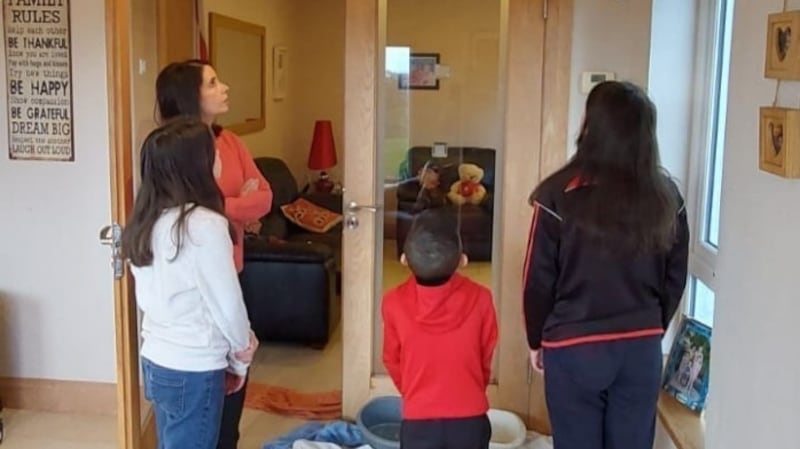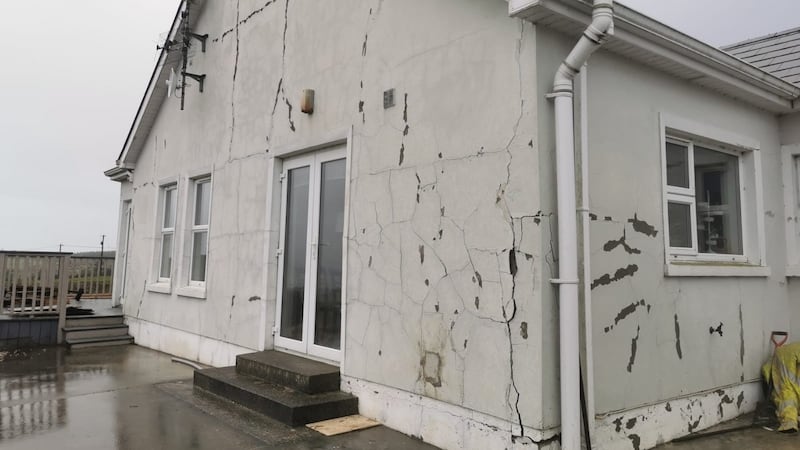As the tail end of Storm Barra swept across the north-west on Wednesday, mica-affected families in Co Donegal battled to protect their crumbling homes from gale force winds and rain.
Met Éireann issued a status orange weather warning for Co Donegal, with the highest wind gust reaching 111km/h in Finner Camp.

Louise Callaghan and her family in Clonmany, Co Donegal were forced to use buckets to collect rainwater running into their home, built in 2005. The family can no longer use their electricity sockets and are relying on extension leads coming from safe sockets.
The mother of three, who began to notice the mica defects in 2014, said her home had rapidly deteriorated and must be demolished.
“Our electricity sockets are leaking rust, so we’re just terrified at this stage of the children getting electrocuted, or just the roof falling down,” she said.
Ms Callaghan first spotted rainwater coming into her home on Saturday, and the family have since been using buckets located around the house to collect the water.
“The rain is constantly dripping in through the wall, coming down onto the floor. It’s entering the conservatory and the kitchen.
“It’s a slow constant leak, your heart just breaks every time it rains because you know it’s just causing more damage and it’s only going to get worse”.
Her priority is now focused on preserving the inside of the house, “I know the outside is destroyed, it’s the inside now that I am terrified of,” she said.
“At this stage I don’t think there can be much more damage only than falling down, there’s not a foot in the wall where there isn’t a crack,” she said.
Ms Callaghan said the introduction of a sliding scale under the Government’s mica redress scheme would make it “impossible” for her family to rebuild as they would still have to pay €97,000 themselves to carry out the necessary works.
Wind
Meanwhile, Claire McDaid and her family in Buncrana have resorted to duct-taping the cracks in her home to keep gale force winds at bay, while rainwater from the storm seeps through the walls in her kitchen.
“About a six-inch piece of the house fell off [on Tuesday], and what is sitting above it is sitting very precariously and hopefully it doesn’t fall off today [Wednesday],” she said.

The mother of two and schoolteacher began to notice cracks in her home seven years ago, and now says her house is “ready to fall, it’s absolutely shocking. We’re probably in the stage now that we shouldn’t be living in it but there is nowhere to go”.
Although the storm was starting to die down on Wednesday, Ms McDaid said it was still “very, very noisy. Because all around the windows are cracking, the windows are warping so they are not closing properly.
“We have them duct-taped up, but the wind still howls through them. Even though they are duct-taped I woke up at 4 am with the shear noise of it.”
Floods
Father-of-two Paul Dunlop noticed “extensive cracking” in his home in Buncrana in 2017 and his main fear from Storm Barra was the structural integrity of his home if it flooded.
Already condemned for demolition, he fears his home will not withstand the pressure of flooding as his mica home is located in a flood-prone zone which flooded heavily in the 2017 Storm Ophelia.
Mr Dunlop said the last time his home flooded in 2017 his son said to him, “daddy, I don’t want to live here anymore”, when his home was surrounded by just under a metre of water.
Mr Dunlop has invested in flood barriers to protect his home, while the communities relies on sand bags an app to track the surrounding water levels.
He says his mica-affected home is damaged with cracks the size of “coins” and bulging blocks.
“It’s dangerous when you live in a house that is structurally compromised because of mica and it’s cracking apart,” he said.









